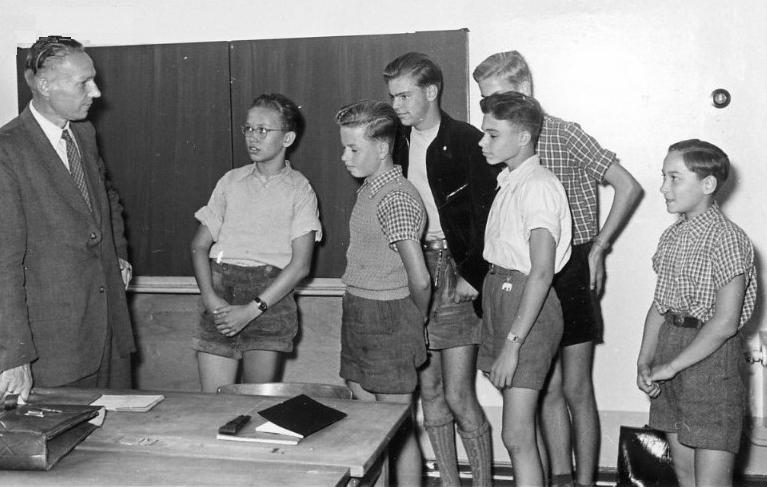
Figure 1.--Here we see some German boys afgter class chatting informally with their teacher. Notice the blackboard. The photograph is undated, but looks like the 1950s. |

|
Class room photographs show changes in German education over time. We do not have much informatuon on the 19th century. While there are quite a number of school portraits from the 19th century, most are outdoor portraits, largely from the end-of-the century. As a result the photographic record is rather limited. As best we can tell, the general approach was quite large numbers of children were crammed into into classrooms crammed with rows of banks, often separated by an asile. The teacher would have a desk at the front. This basic approach did not cjange a great deal during the century. Tghe overwealming impression is stark, crowded classrooms. While we know very little about the 19th century, we do know a great deal about the German classroom in the 20th century, The arrangement of the classroom is the most readily apparent feature, but a host of other interesting information can be drawn from these photographs. One notable onservation is how stark he classrooms were with few teaching aids beyond a blackboard a a fews maps. This did not begin to change until the 1960s. While many of the photographs are undated, it is usually possible to roughly assess the decade. Major chances did not occur when the German Empire was formed (1871) or when the Weimar Reublic was estanlished (1918) or even after the NAZI seizure of power (1933). There were, hoever major changes after World War II (1939-45). We do not yet have information on how educational approches differed in East and West Germany. We see more informal relationships depicted in the classroom after World War II. We see more spacious classrooms with smaller classes and the children spread out with separate desks. In addition to changing teaching methods, a factor here was the need to rebuild many city schools because of the massive destruction resilting from the Allied Strategic bombing campaign. We do not yet have information on the 21st century.
Class room photographs show changes in German education over time, although the classrooms seem fairly standard during much of the 19th century We do not have much informatuon on the 19th century. While there are quite a number of school portraits from the 19th century, most are outdoor portraits, largely from the end-of-the century. As aesult the photographic record is rather limited. As best we can tell, the general approach was quite large numbers of children were crammed into into classrooms crammed with rows of banks, often separated by an asile. The teacher would have a desk at the front. This basic approach did not change a great deal during the century. The overwealming impression is stark, crowded classrooms. We do not notice major chances when the German Empire was formed (1871). This was because education primarily remained a stat (Landen) function. Our limited photographic archive, unfortunalely makes this diffult to assess.
While we know very little about the 19th century, we do know a great deal about the German classroom in the 20th century, And we see substantial changes, especially after World War II. The general trend through the century was for smaller classess and more separated desks. The arrangement of the classroom is the most readily apparent feature, but a host of other interesting information can be drawn from these photographs.
We notioce a shift from rows of banks to desks that might accomodate two students, although we still see the banks into the 1940s. One notable onservation is how stark he classrooms were with few teaching aids beyond a blackboard a a fews maps. This did not begin to change until the 1960s. While many of the photographs are undated, it is usually possible to roughly assess the decade. Major chances did not occur when the German Empire was formed (1871) or when the Weimar Reublic was estanlished (1918) or even after the NAZI seizure of power (1933). There were, however major changes after World War II (1939-45). We do not yet have information on how educational approches differed in East and West Germany. We see more informal relationships depicted in the classroom after World War II. We see more spacious classrooms with smaller classes and the children spread out with separate desks. In addition to changing teaching methods, a factor here was the need to rebuild many city schools because of the massive destruction resilting from the Allied Strategic bombing campaign. And the German Economic Miracle meant that at least in the West, substantial funds were availble for school construction and classroom amenities.
We do not yet have information on the 21st century.
Related Chronolgy Pages in the Boys' Historical Web Site
[Main Chronology Page]
[The 1880s]
[The 1890s]
[The 1900s]
[The 1910s]
[The 1920s]
[The 1930s]
[The 1940s]
[The 1950s]
[The 1960s]
[The 1970s]
[The 1980s]
[The 1990s]
[The 2000s]
Related Style Pages in the Boys' Historical Web Site
[Main school uniform page]
[Main country page]
[Long pants suits]
[Short pants suits]
[Socks]
[Eton suits]
[Jacket and trousers]
[Blazer
[School sandals]
Navigate the Boys' Historical Clothing School Uniform Pages
[Return to the Main Geman classroom academics page]
[Return to the Main German activities page]
[Return to the Main School Uniform Page]
[Australia]
[England]
[France]
[Germany]
[Italy]
[Japan]
[New Zealand]
[Scotland]
[United States]
Navigate the Boys' Historical Clothing Web Page
[Introduction]
[Activities]
[Biographies]
[Chronology]
[Clothing styles]
[Countries]
[Bibliographies]
[Contributions]
[FAQs]
[Glossaries]
[Images]
[Links]
[Registration]
[Tools]
[Boys' Clothing Home]
